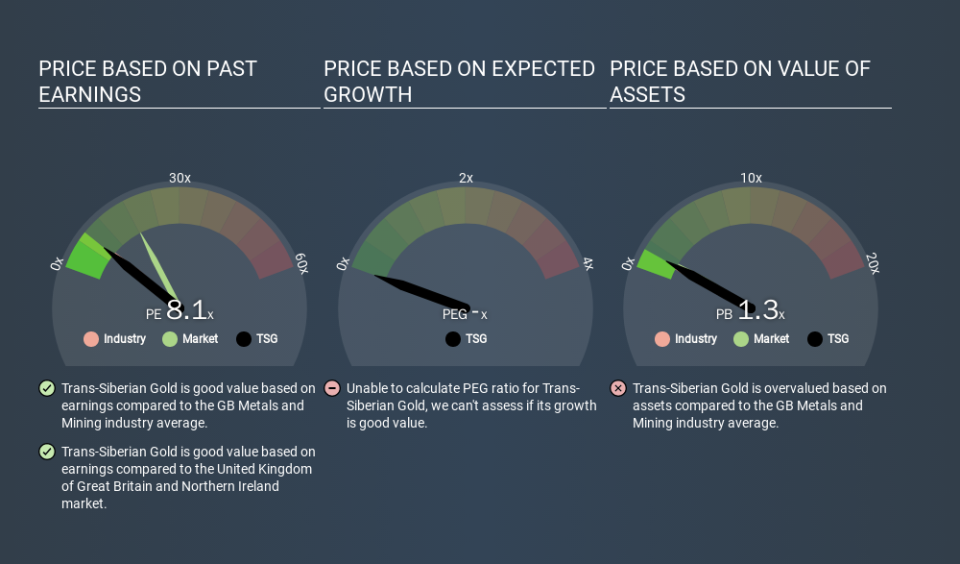A Rising Share Price Has Us Looking Closely At Trans-Siberian Gold plc's (LON:TSG) P/E Ratio

Trans-Siberian Gold (LON:TSG) shareholders are no doubt pleased to see that the share price has bounced 31% in the last month alone, although it is still down 10% over the last quarter. That's tops off a massive gain of 158% in the last year.
All else being equal, a sharp share price increase should make a stock less attractive to potential investors. In the long term, share prices tend to follow earnings per share, but in the short term prices bounce around in response to short term factors (which are not always obvious). The implication here is that deep value investors might steer clear when expectations of a company are too high. One way to gauge market expectations of a stock is to look at its Price to Earnings Ratio (PE Ratio). Investors have optimistic expectations of companies with higher P/E ratios, compared to companies with lower P/E ratios.
View our latest analysis for Trans-Siberian Gold
Does Trans-Siberian Gold Have A Relatively High Or Low P/E For Its Industry?
Trans-Siberian Gold's P/E of 8.05 indicates relatively low sentiment towards the stock. If you look at the image below, you can see Trans-Siberian Gold has a lower P/E than the average (9.1) in the metals and mining industry classification.
Trans-Siberian Gold's P/E tells us that market participants think it will not fare as well as its peers in the same industry. Since the market seems unimpressed with Trans-Siberian Gold, it's quite possible it could surprise on the upside. If you consider the stock interesting, further research is recommended. For example, I often monitor director buying and selling.
How Growth Rates Impact P/E Ratios
Generally speaking the rate of earnings growth has a profound impact on a company's P/E multiple. When earnings grow, the 'E' increases, over time. And in that case, the P/E ratio itself will drop rather quickly. A lower P/E should indicate the stock is cheap relative to others -- and that may attract buyers.
In the last year, Trans-Siberian Gold grew EPS like Taylor Swift grew her fan base back in 2010; the 217% gain was both fast and well deserved. And earnings per share have improved by 31% annually, over the last three years. So you might say it really deserves to have an above-average P/E ratio.
A Limitation: P/E Ratios Ignore Debt and Cash In The Bank
It's important to note that the P/E ratio considers the market capitalization, not the enterprise value. In other words, it does not consider any debt or cash that the company may have on the balance sheet. Hypothetically, a company could reduce its future P/E ratio by spending its cash (or taking on debt) to achieve higher earnings.
Spending on growth might be good or bad a few years later, but the point is that the P/E ratio does not account for the option (or lack thereof).
How Does Trans-Siberian Gold's Debt Impact Its P/E Ratio?
Trans-Siberian Gold's net debt is 9.4% of its market cap. The market might award it a higher P/E ratio if it had net cash, but its unlikely this low level of net borrowing is having a big impact on the P/E multiple.
The Bottom Line On Trans-Siberian Gold's P/E Ratio
Trans-Siberian Gold has a P/E of 8.1. That's below the average in the GB market, which is 18.2. The company does have a little debt, and EPS growth was good last year. The low P/E ratio suggests current market expectations are muted, implying these levels of growth will not continue. What is very clear is that the market has become less pessimistic about Trans-Siberian Gold over the last month, with the P/E ratio rising from 6.2 back then to 8.1 today. For those who like to invest in turnarounds, that might mean it's time to put the stock on a watchlist, or research it. But others might consider the opportunity to have passed.
When the market is wrong about a stock, it gives savvy investors an opportunity. As value investor Benjamin Graham famously said, 'In the short run, the market is a voting machine but in the long run, it is a weighing machine. Although we don't have analyst forecasts you could get a better understanding of its growth by checking out this more detailed historical graph of earnings, revenue and cash flow.
Of course, you might find a fantastic investment by looking at a few good candidates. So take a peek at this free list of companies with modest (or no) debt, trading on a P/E below 20.
If you spot an error that warrants correction, please contact the editor at editorial-team@simplywallst.com. This article by Simply Wall St is general in nature. It does not constitute a recommendation to buy or sell any stock, and does not take account of your objectives, or your financial situation. Simply Wall St has no position in the stocks mentioned.
We aim to bring you long-term focused research analysis driven by fundamental data. Note that our analysis may not factor in the latest price-sensitive company announcements or qualitative material. Thank you for reading.

 Yahoo Finance
Yahoo Finance 
